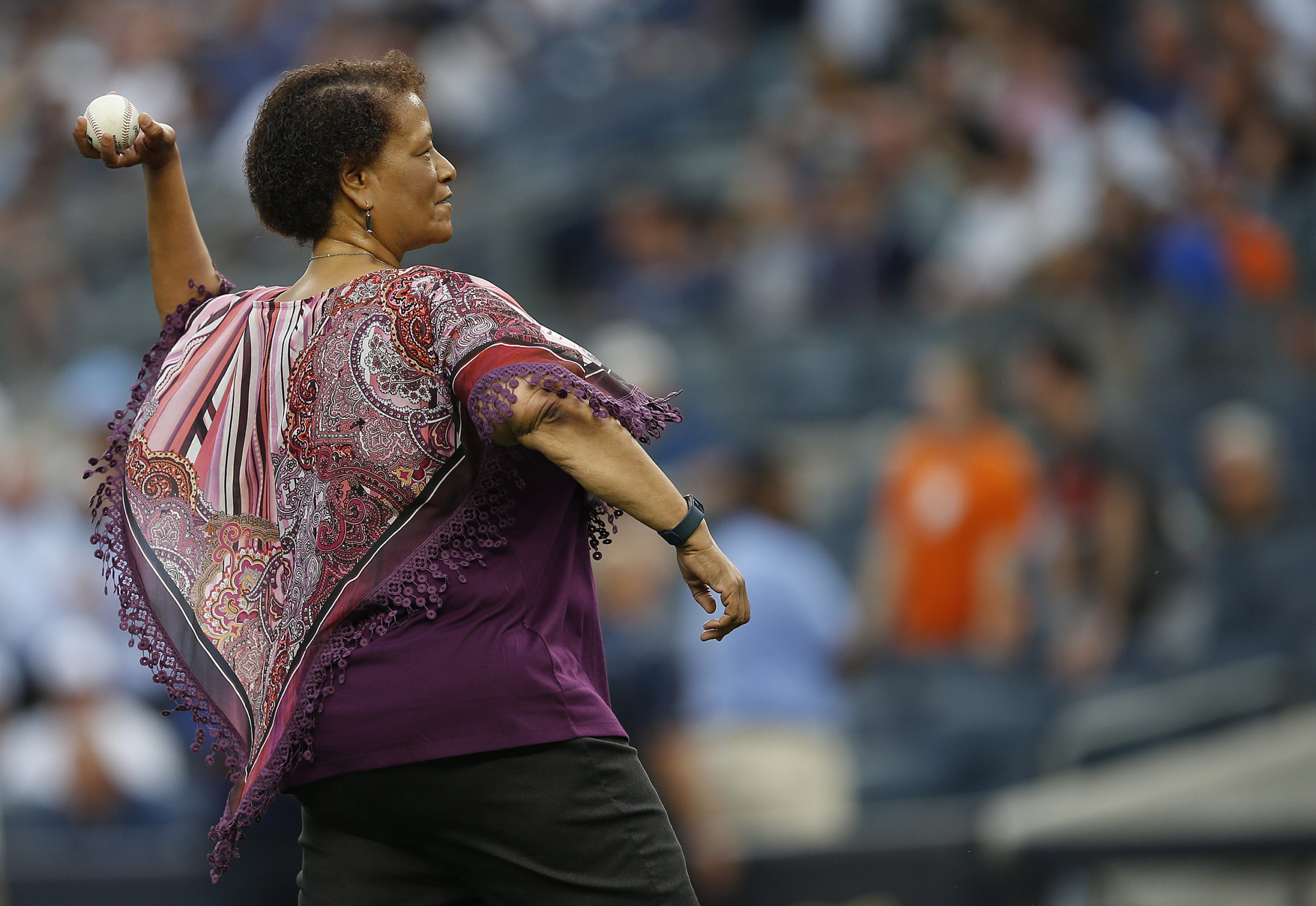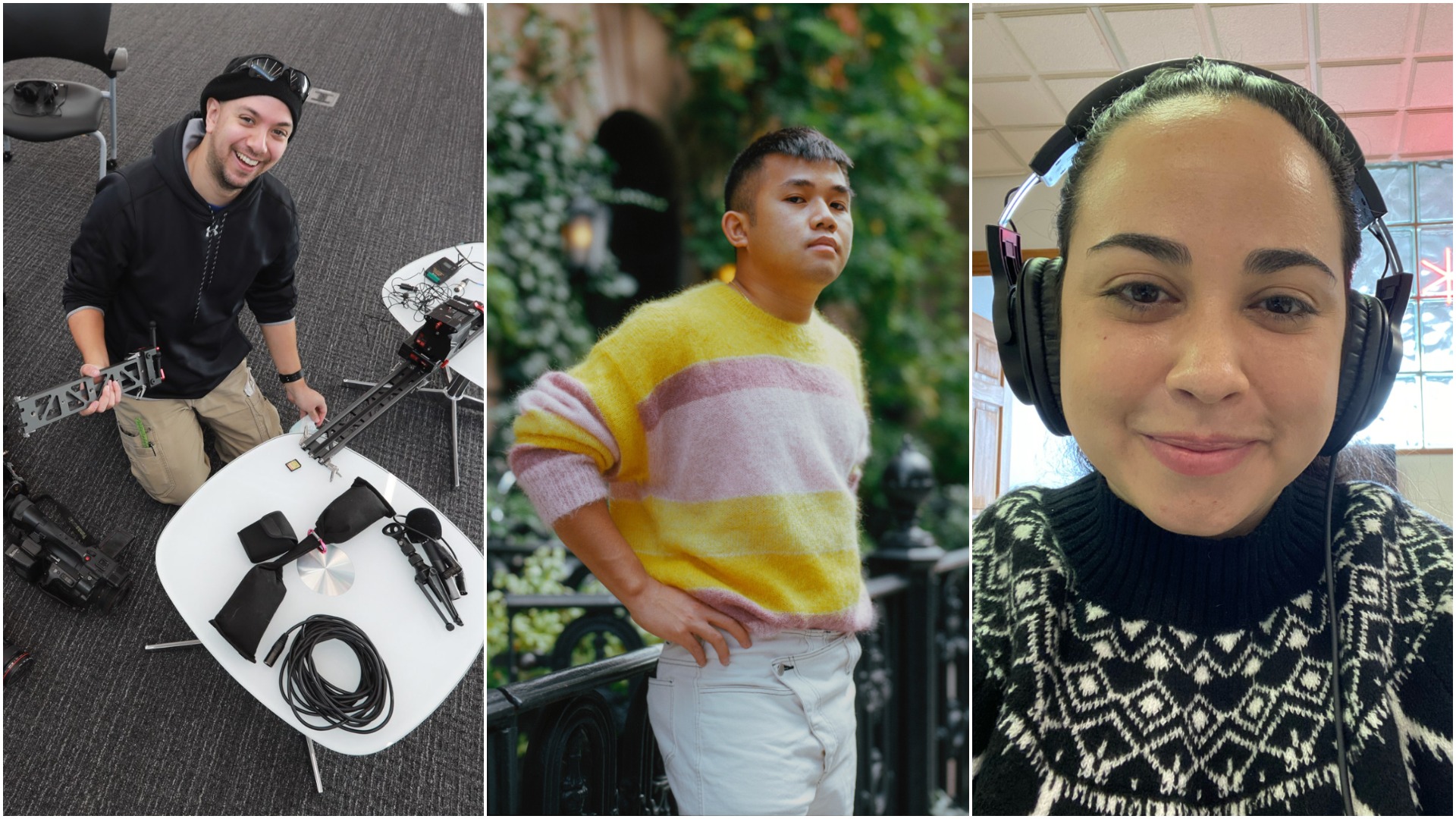Claire Smith’s career is so remarkable that it has a place in the hall of fame.
She was the first woman to be recognized with an annual award from the Baseball Writers’ Association of America. That award is displayed at the National Baseball Hall of Fame in Cooperstown, New York.
Smith was the first woman to cover baseball full time. She worked at The New York Times, The Philadelphia Inquirer and The Hartford Courant. In 2007, she joined ESPN as a news editor. In 2011, she was honored by the National Association of Black Journalists with an annual legacy award.
2022 would have marked her 40th year covering baseball.
She got so close.
In November 2020, just after the World Series, ESPN laid off Smith and hundreds of her colleagues.
“They did not discriminate,” Smith said. “Whole departments were eliminated.”
She’s still in mourning for a job she didn’t choose to leave and colleagues she didn’t get to say goodbye to. Smith tries not to slip into anger.
“It was devastating,” she said.
The pandemic cut short lives, disrupted whole industries and ended careers. By our count, more than 100 newsrooms have closed. Since March 2020, we’ve been tracking layoffs, too, but we don’t know much about who got laid off and what’s happened to them since. We do know that newsrooms of all sizes and mediums have mostly stayed white, despite years of declarations and missed goals.
So what did the pandemic do to the careers of journalists of color?
The answer has felt both evident and unconfirmable.
In the summer of 2020, I heard from two journalists who wanted to work with me and dig deeper into the newsroom layoffs I’d been gathering. Specifically, they wanted to understand how the pandemic affected the careers of journalists of color.
I met with Mazin Sidahmed and Moiz Syed in, of course, an early pandemic video chat.
“We thought this could actually be a moment where we could look at the data and find out how many JOCs are actually left and what does that say about our industry,” said Sidahmed, co-executive director of Documented, a nonprofit newsroom in New York City that covers immigrants and immigration policy.
Using money from the News Integrity Initiative, they hired researcher Rima Parikh to dig deeper. In five months of work, she found no clear and consistent data that could help us tell this story.
What she did find were a few reasons why that clear and consistent data does not exist.
This story deals with those reasons, which can mostly be summed up like this: For an industry that prizes transparency, we’re experts at asking for it and rotten at actually offering it.

Sportswriter Claire Smith throws out the ceremonial first pitch before a baseball game between the New York Mets and the New York Yankees Monday, Aug. 14, 2017, at Yankee Stadium in New York. (AP Photo/Rich Schultz)
What we learned
It started with a giant spreadsheet with thousands of layoffs and furloughs.
“What we wanted to find out, at the beginning, was where are the places where journalists of color were working and laid off,” Parikh said.
She worked through our list and similar tracking from the Tow Center for Digital Journalism to look for places that had buyouts, closures, layoffs and furloughs. Parikh tried narrowing her search by location. And she tried to look into specific mediums, like TV, radio and newspapers. With each attempt, she hit the same problem.
“This stuff is not really that public.”
For 23 months, I’ve maintained Poynter’s list of layoffs, and a lot of those entries came from tips or people sharing the “personal news” tweets of journalists who’d been laid off. Rarely were newsrooms themselves the source. Those that did announce layoffs often didn’t include names. Names, of course, don’t tell us race or ethnicity, but they could at least have offered a place to start.
When Parikh dug in, she found the same issues blocking the bigger picture again and again.
They include:
- Lack of public notice about who was laid off and where
- A reluctance among some journalists to say anything publicly
- Growing use of nondisclosure agreements that include non-disparagement agreements
“A lot of the news organizations and the people who are affected by these layoffs, it happens under this cloak of darkness and silence,” Sidahmed said. “It’s actually really hard to get at. We don’t know how many JOCs were laid off in this wave. We don’t even know how many journalists lost their jobs.”
RELATED TRAINING: Enroll in Building an Ethical Newsroom with Kelly McBride by March 1, 2022.
“We were trying so hard to get a grasp on this quantitatively,” said Syed, a lead product designer at Mozilla. “It just felt like we were in quicksand and we couldn’t at any moment have a complete picture.”
We can gather some of that picture’s fragments, though, which include the experiences of journalists who were laid off during the pandemic. Here are three of them.

From left, Nicolas Galindo, Khoa Tran and Andrea Asuaje. (Credit/Courtesy: Doral Chenoweth, Khoa Tran and Andrea Asuaje)
Nicolas, Khoa and Andrea
Nicolas Galindo, Khoa Tran and Andrea Asuaje are three among thousands of journalists laid off during the pandemic. None of them thinks they were targeted because of race or ethnicity. But they leave the newsrooms and communities they covered without their skills, experience and perspectives.
One is working his way back into the news. One found another job. One left legacy journalism.
Galindo was the chief photographer at a Gannett newspaper in Louisiana. He recently finished a six-month photo internship in December at The Columbus Dispatch.
Galindo was laid off in the spring of 2020 from The (Monroe, Louisiana) News-Star, where he worked as the chief (and only) photographer. He was one of hundreds of Gannett employees to lose their jobs during the pandemic.
Galindo also represents a different category of underrepresented people in journalism. He’s a Marine Corps veteran who served in Iraq. After getting laid off, Galindo moved home to Kokomo, Indiana, to live with his dad and save money. He knew if he went back to school using the GI Bill, he’d be eligible for internships, which he could only afford to take if they were paid.
“Honestly, nothing was off the table when you get laid off during the worst pandemic in 100 years,” he said.
He went back to Southern Illinois University for a master’s program, which made him eligible for paid internships. At first, it was sobering to be in that role after two years of being in charge.
Galindo, who is Mexican American, hopes his master’s degree will set him apart from the competition when he graduates in December 2022. He wants to stay in journalism.
He’s also questioning it as a viable career.
Khoa Tran got the layoff call the day before April Fools’ in 2020.
He kind of expected it.
Tran, who was the art director at Atlanta Magazine, has watched magazines cut budgets for years. The editors were kind about it and offered to help with his resume. Tran applied for jobs everywhere during a time when he knew a lot of other laid-off journalists were also looking for work.
It took him one year before he found his way back into a newsroom. Now, he’s a senior designer at Vanity Fair.
Tran, who is Vietnamese American, sees an industry trying to fix its diversity problem.
“I hope that they mean it,” he said. “I also don’t want people to hire me because I’m Asian. It’s a little confusing. I want a job, but I also don’t want them to hire me because they want to brand themselves better.”
Andrea Asuaje heard that WBUR, Boston’s public radio station, was going to have layoffs. She did not think she’d be one of them. But when it did happen, the experience wasn’t new. Asuaje, who is Latina, was laid off a decade ago from The (Jacksonville) Florida Times-Union, a Gannett paper.
“I think I was less anxious about it because I knew the feeling,” she said, “which is really depressing to say.”
RELATED: Subscribe to The Collective, Poynter’s twice-monthly newsletter by journalists of color, for journalists of color.
Asuaje worked as a reporter, producer and co-host of a podcast and radio series called “Kind World,” which was also canceled. She was laid off in June, but asked to stick around until the end of July to finish the season.
Asuaje spent the first five years of her career in newspapers before shifting to work in public media. She shifted again in 2020 after the layoff, joining Rococo Punch, an indy podcast production company based in Boston.
That move meant leaving legacy journalism.
“NPR and public media have a very special purpose and a very special mission in the media market. I think it’s essential, and I value it,” she said. “But I could see what was happening, and I couldn’t find my place there anymore.”
The big chill
In her months of research, Parikh found a few trends.
One: Newsrooms aren’t usually very open about layoffs.
That’s not new, but I did notice that if a newsroom reported on its own layoff, it was often small and locally owned. That sounds right, said Penny Abernathy, visiting professor at Northwestern University’s Medill School of Journalism.
“If you’re still independent and family-owned with people located in the community, there is a real notion of being tied to the community and that the trust of people in that community resides in the people that cover them on a daily basis,” she said.
Another issue: Industry and personal forces made some journalists, particularly broadcast journalists, reluctant to speak publicly about layoffs.
That’s true, said Joie Chen, a veteran broadcaster and senior adviser at Poynter. And there are a number of reasons.
First: Those layoffs aren’t always technically layoffs.
A growing number of people in broadcast news work under contract, Chen said. When it’s time to renew, the company can choose not to or it can offer bad terms, and if the broadcaster isn’t renewed or doesn’t sign the contract, it’s not reported as a layoff.
Second: There is some reluctance for people who are the face of the news to talk publicly about losing their jobs because they’re so well known, Chen said.
“It’s embarrassing, right? It’s embarrassing to lose your job,” said Chen, who has been laid off five times. “That’s a difficult thing for many people of color because you’ve worked hard to achieve a role and then, for reasons that don’t have anything to do with your performance, you lost that job.”
When people are so affiliated with the brand of their newsroom, Chen said, it’s like a public divorce.
Third: Culture and family can also play a role.
“I don’t know that this applies to other cultures, but I will tell you that as an Asian person and as a child of immigrants, I have a particular sensitivity to it,” Chen said.
When she was laid off from CNN in 2001, Chen knew that she was one of the few Asian Americans on national news, “and so I had a certain sense of obligation to my community. I felt like in some sense I was letting the community down.”
And finally: They might have signed an NDA.
Parikh found, regardless of medium, people who were reluctant to say anything on the record if they’d signed an NDA, which often includes non-disparagement agreements.
Why? Signing that NDA is often a requirement to get severance pay. It also appears to be pretty common.
In 2017, Columbia Journalism Review reported that employees who were laid off at HuffPost, Mic, Vice, The Guardian and MTV had all signed such agreements. Gannett, the largest newspaper chain in America, includes NDAs in its severance packages.
“Is telling the truth about you being laid off critical of Gannett? Maybe,” said Arizona Republic Guild chair Rebekah Sanders. “It just has that chilling effect that people don’t want to put the little amount of money they got from severance at risk.”
NDAs can also conceal information about why people were laid off, obscuring details about company culture, experts say. Employees who sign them often cannot share details about any discrimination they faced or diversity issues within the company.

This screenshot includes part of a 2019 severance letter template from Gannett, which Poynter obtained, and includes a non-disparagement clause.
What we otherwise know
Meredith Clark is not surprised by any of this.
Clark, an associate professor at Northeastern University, started working with the News Leaders Association (formerly ASNE) in 2018 to rework an annual newsroom diversity survey that had a plummeting response rate.
The survey itself has struggled for years to get newsrooms to take part.
“The thing is, journalism as an institution, as a business, has a vested interest in continuing to isolate people in terms of their knowledge of what the field actually looks like,” Clark said. “And the corporatization of journalism helps with that because it’s easy to say, ‘Oh, this is a problem for HR,’ or, ‘Oh, because of legal we can’t do this.’”
NLA has a plan to make structural changes to the way that diversity information is collected and disseminated, Clark said, “and that plan will require the part of decision-makers in our industry; awards committees, funders, folks who have the levers of power.”
Without real data, we can place the blame for journalism’s lack of diversity on other issues: There’s a pipeline problem, people are leaving the industry, retention is the issue, etc. etc. etc.
Clark sums it up like this: “We live and work in a world and a profession that requires significant data in order to admit what we all otherwise know anecdotally.”
Progress
Since I started working with Parikh, Syed and Sidahmed, the industry has seen some important changes.
- Several national and local newsrooms are being led by journalists of color, in some cases for the first time in their histories. They include the Miami Herald, The Dallas Morning News, the (Utica, New York) Observer-Dispatch and (Herkimer, New York) Times Telegram, the Houston Chronicle, GBH in Boston, MSNBC and Teen Vogue.
- Newsrooms, including the Los Angeles Times and The Kansas City Star, have turned their skills inward and reported on a legacy of racist coverage and how it must change.
- Companies, including Gannett, The Washington Post, Minnesota Public Radio, The Philadelphia Inquirer and NBCUniversal are sharing staffing numbers, diversity and inclusion plans and setting deadlines to achieve them.
- There’s a coalition of grassroots groups building resources for diversity and inclusion in journalism, including the Diversity Pledge Institute, as well as others, such as the Maynard Institute, that have been at it for decades.
- A recent study from the Reuters Institute concludes that an increase in remote/hybrid work could lead to more diverse newsrooms.
- Unions are also working with newsrooms to offer some protection for journalists of color.
Lowell Peterson, executive director of the Writers Guild of America, East, which represents a number of digital outlets including Vice, Vox and HuffPost, said the union was able to convert a number of layoffs into furloughs during the pandemic.
Many unions have also made improving diversity one of their key goals when negotiating new contracts. Media unions have worked to expose pay gaps and won language requiring that a certain percentage of interviews for open positions go to members of underrepresented communities.
“We also look at the bigger picture,” said NewsGuild of New York president Susan DeCarava. “What is going to foster retention? What fosters professional development? How does the company communicate with its entire workforce about what its priorities are? Sometimes those are things that don’t seem to obviously impact diversity within roles within a newsroom, but it does actually address some of the issues that we are grappling with as a whole.”

(Screenshot, Klein College of Media and Communication, Temple University)
Onward
Claire Smith didn’t plan to stay at ESPN for too much longer. She knew her age and salary were working against her. The layoff made the choice.
And she had a very solid plan B.
For three years, Smith had been in talks with Temple University. The school wanted to open a sports media center and name it after her. After being laid off, those talks sped up.
“I was blessed that my alma mater was showing me a way to go home,” she said.
In October 2021, Temple announced The Claire Smith Center For Sports Media.
Now, she’s teaching a new generation of journalists at a school with one of the most diverse student populations in the country. Smith started teaching in January.
“If they go into the world knowing that diversity is invaluable and beautiful, then that’s going to help.”
But in a time when so many newsrooms and journalists are struggling to survive, she worries that diversity and inclusion aren’t even high on the list of priorities.
There’s a crisis within a crisis, she said.
“How do you hold an industry accountable in its hiring practices when it’s doing more layoffs than hiring?”
Poynter reporter Angela Fu contributed to this story.







